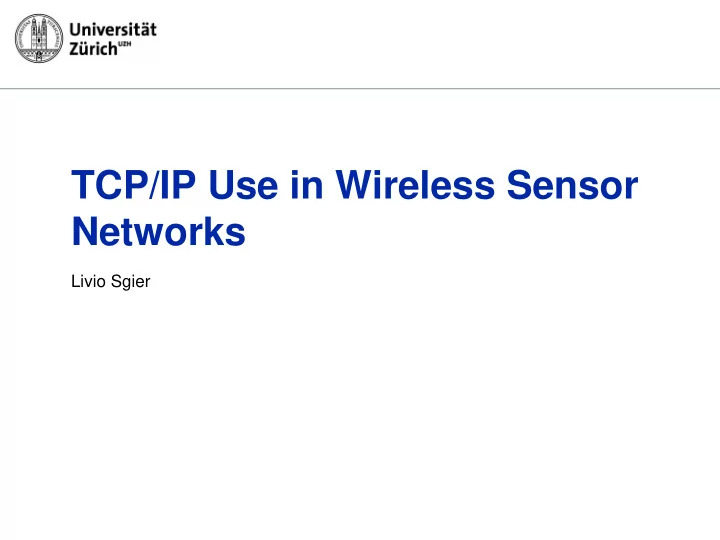

TCP/IP Use in Wireless Sensor Networks Livio Sgier
Roadmap ● Introduction and Motivation ● TCP/IP in General ● TCP/IP in Wireless Sensor Networks ● Summary and Conclusion Page 2
Roadmap ● Introduction and Motivation ● TCP/IP in General ● TCP/IP in Wireless Sensor Networks ● Summary and Conclusion Page 3
Internet of Things (IoT) The IoT is the network of physical objects—devices, vehicles, buildings and other items—embedded with electronics , software , sensors , and network connectivity that enables these objects to collect and exchange data. Source: https://www.linkedin.com/topic/internet-of-things Page 4
Wireless Sensor Networks (WSN) WSNs are spatially distributed autonomous sensors to monitor physical or environmental conditions, such as temperature, sound, pressure, etc. and to cooperatively pass their data through the network to a main location . ● CPU: 8-bit AVR, 16 MHz ● 128 KB Instruction Mem. ● 8 KB RAM A. Dunkels: Towards TCP/IP for Wireless Sensor Networks ; March 2005 Page 5
Roadmap ● Introduction and Motivation ● TCP/IP in General ● TCP/IP in Wireless Sensor Networks ● Summary and Conclusion Page 6
TCP/IP Protocol Stack Source: http://i.stack.imgur.com/FOfAU.jpg ● Physical/Network Access Layer: Networking hardware transmission (IEEE 802.3, 802.11) ● Internet/Network Layer : Addressing, Routing ( IP , ICMP, etc.) ● Transport Layer : Host-to-Host communication ( TCP , UDP, SCTP, etc.) ● Application Layer: Process-to-process communication (Bitcoin, FTP, etc.) Page 7
Internet Protocol (IP) Header Format Corresponding RFC: https://tools.ietf.org/html/rfc791 Page 8
Transmission Control Protocol (TCP) Header Format Corresponding RFC: https://tools.ietf.org/html/rfc793 Page 9
Roadmap ● Introduction and Motivation ● TCP/IP in General ● TCP/IP in Wireless Sensor Networks ● Summary and Conclusion Page 10
TCP/IP in WSNs ● Facilitate monitoring, management, deployment, access ● Challenges Hardware resources ( energy consumption , radio range, memory, ● computational capacity) ● TCP characteristics in wireless networks → Modifications and adaptations required! Page 11
Spatial IP Address Assignment ⚡ ● Autonomous : GPS on all nodes ( high energy consumption) ● Semi-autonomous : GPS/manual config. on some nodes Adam Dunkels, Thiemo Voigt, and Juan Alonso: Making TCP/IP Viable for Wireless Sensor Networks ; January 2004 Page 12
Routing ● Greedy Perimeter Stateless Routing (GPSR) Contrary to Ad-Hoc On Demand Distance Vector Routing (AODV) ● Difference between WSNs and Mobile Ad-Hoc Networks (MANET) ● ● Directed Diffusion Data-centric instead of address-centric ● Supports aggregation ● Application-aware ● ● Distributed Hash Tables (e.g., ScatterPastry) Creating a routing overlay ● Page 13
Header Compression (1) ● Goal: Have as much space as possible in packet for payload ● Traditional IP + TCP Header = 40 Byte Page 14
Header Compression (2) ● Only save difference of value, not actual value. Omit if difference is 0. ● Assumptions No additional IP and TCP options ● Push Flag No Fragmentation ● In-Order Delivery ● No Time to Live ● → Header size ranges between 4 and 12 Byte Page 15
Distributed TCP Caching ● Wireless transmission characteristics High bit-error rates ● ● High latencies Limited Bandwidth ● Mobility ● Temporary Disconnections ● ● Distributed TCP Caching offers significant improvements Caching TCP segments ● Local retransmission ● → Energy consumption balanced → Reducing overall TCP segments traffic Page 16
Distributed TCP Caching - Example 1) Sender sends 3 segments to receiver Node = Intermediate Node on communication path 2) Segments 1 and 2 lost, cached locally 3) Nodes 5 and 7 local retransmission ● Positive ACKs on link-layer to spot loss ● Fast retransmission ● Congestion threshold decreasing Adam Dunkels, Thiemo Voigt, and Juan Alonso: Making TCP/IP Viable for Wireless Sensor Networks ; January 2004 Page 17
Roadmap ● Introduction and Motivation ● TCP/IP in General ● TCP/IP in Wireless Sensor Networks ● Summary and Conclusion Page 18
Summary and Conclusion ● Modifications on the Network Layer Spatial IP Address Assignment ● Routing ● Modifications on the Transport Layer ● Distributed TCP Caching ● Overall improvement strategies ● Header Compression ● → Yes, TCP/IP can be and is used in WSNs (e.g., lwIP, uIP) Page 19
Thank you... Source: http://espei.com/wp-content/uploads/2013/05/equipmentprotection3.png Page 20
Question 1 What do you think IoT will look like in 5-10 years? Page 21
Question 2 Does it make sense “at the moment” to include TCP/IP by default for current WSN hardware? Page 22
Question 3 The role of standardization? Source: https://cagenutsandbolts.files.wordpress.com/2015/12/network-communication-protocols-map.jpg Page 23
Recommend
More recommend